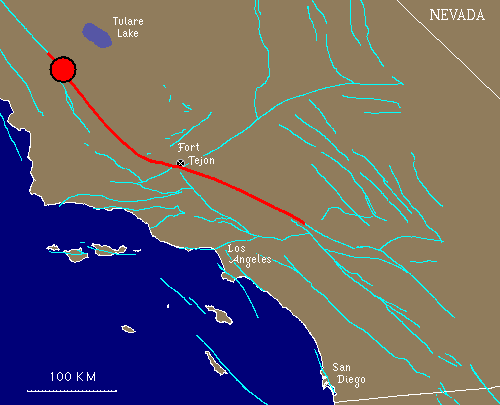
TIME January 9, 1857 / about 8:20 am PST
LOCATION 35° 43' N, 120° 19' W about 72 km (45 miles) northeast of San Luis Obispo, about 120 km (75 miles) northwest of Bakersfield, as shown on the map (epicenter location uncertain).
MAGNITUDE MW8.0 (approx.)
TYPE OF FAULTING right-lateral strike-slip
FAULT RUPTURED San Andreas fault
LENGTH OF SURFACE RUPTURE about 360 km (225 miles)
MAXIMUM SURFACE OFFSET about 9 meters (30 feet)
The
Fort Tejon earthquake of 1857 was one of the greatest earthquakes ever
recorded in the U.S., and left an amazing surface rupture scar over 350
kilometers in length along the
San Andreas fault. Yet, despite the immense scale of this quake, only
two people were reported killed by the effects of the shock -- a woman at
Reed's Ranch near Fort Tejon was killed by the collapse of an adobe house,
and an elderly man fell dead in a plaza in the Los Angeles area (?).
The fact that only two lives were lost was primarily due to the the nature
of the quake's setting; California in 1857 was sparsely populated,
especially in the regions of strongest shaking, and this fact, along with
good fortune, kept the loss of life to a minimum. The effects of the quake
were quite dramatic, even frightening. Were the Fort Tejon shock to happen
today, the damage would easily run into billions of dollars, and the loss of
life would likely be substantial, as the present day communities of
Wrightwood, Palmdale, Frazier Park, and Taft (among others) all lie upon or
near the 1857 rupture area.
As a result of the shaking, the current of the Kern River was turned
upstream, and water ran four feet deep over its banks. The waters of
Tulare Lake were thrown upon its shores, stranding fish miles from the
original lake bed. The waters of the Mokelumne River were thrown upon its
banks, reportedly leaving the bed dry in places. The Los Angeles River was
reportedly flung out of its bed, too. Cracks appeared in the ground near San
Bernadino and in the San Gabriel Valley. Some of the artesian wells in Santa
Clara Valley ceased to flow, and others increased in output. New springs
were formed near Santa Barbara and San Fernando. Ridges (moletracks) several
meters wide and over a meter high were formed in several places. In Ventura,
the mission sustained considerable damage, and part of the church tower
collapsed. At Fort Tejon, where shaking was greatest, damage was severe. All
around southern and central California, the strong shaking caused by the
1857 shock was reported to have lasted for at least one minute, possibly two
or three!
The surface rupture caused by the quake was extensive. The
San Andreas fault broke the surface continuously for at least
The location of the epicenter of the Fort Tejon earthquake is not known. As
the name suggests, one idea is to locate it near the area of strongest
reported shaking -- Fort Tejon. However, because there is evidence that
foreshocks to the 1857 earthquake may have occurred in the Parkfield area,
it is located on this map near the northwestern end of the surface rupture,
just southeast of Parkfield, near Cholame.
(Note: locating it near Fort Tejon would also have caused interference on
the map between this quake's symbol and that of the
1952 Kern County quake. Hence, for both these reasons, the Cholame
location was chosen.)
![]()
Below is a map of southern California with various place names marked, and
the surface traces of major faults drawn in blue-green. The theoretical "Cholame"
epicenter of the 1857 earthquake is marked with the large red dot -- Fort
Tejon is shown by a white "x" on black -- and that part of the San Andreas
fault which exhibited surface rupture during the earthquake is shown in red.

REFERENCES
